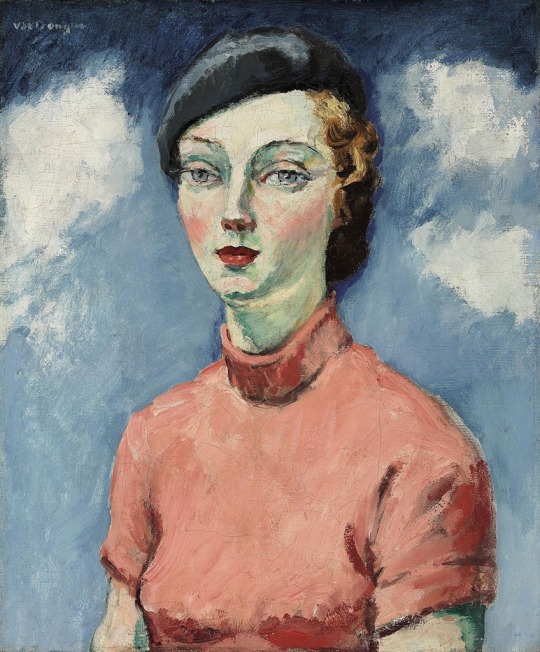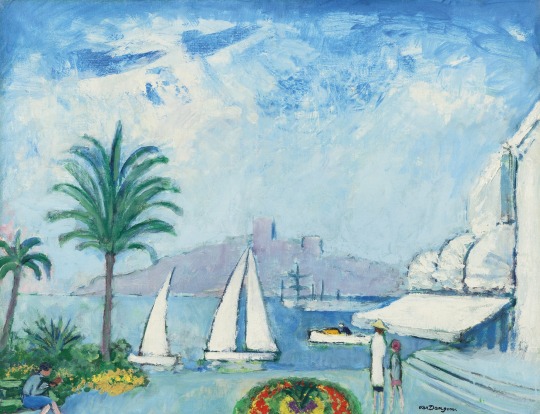#cornelis van dongen
Text

Kees van Dongen
The Corn Poppy
1919
oil on canvas
#kees van dongen#painting#classic art#classical art#20th century art#fauvism#oil painting#oil on canvas#light academia#fauvist#corn poppy
20 notes
·
View notes
Text

Kees van Dongen aka Cornelis Theodorus Maria van Dongen (Dutch-French, 1877-1968, b. Rotterdam, Netherlands, d. Monte Carlo, Monaco) - La Femme Aux Chats, 1912, Paintings: Oil on Canvas
15 notes
·
View notes
Photo

1918 Kees Van Dongen, La Casati (Marchesa Luisa Casati).
"Kees immediately wanted a piece of Luisa and barely hid from it. This seemingly untactical appetite had seduced the woman, flattered by the harshness of the man's desire. What the Marchioness did not understand was that the attraction she had exerted on Cornelis Theodorus Marie Van Dongen of his real name was due in large part to his fortune. The poor painter's fascination with the rich heiress, if she was interested, was no less sincere. Luisa had taken him out of the Bateau-Lavoir (...) The Marquise introduced him to the beautiful world and Kees Van Dongen became the portraitist of the Tout-Paris. She did not ask for the exclusivity of her lover's caresses, on the contrary, she was delighted that he moved in with Jasmy Jacob called "the Divine." (x)
#1918#painting#kees van dongen#la casati#marchesa luisa casati#la marquesa#la marquesa luisa casati#La Marquise Casati#la marchesa#la marchesa luisa casati#luisa casati#marquise casati#marchesa casati#Marchesa Casati Stampa#Luisa Casati Stampa di Soncino#Luisa Marchesa Casati Stampa Di Soncino#Marchesa Casati Stampa di Soncino#Marquise Casati Stampa di Soncino#luisa amman casati#Luisa Adele Rosa Maria von Amman#Luisa Adele Rosa Maria Amman#Luisa Amman#amman#eccentrics#the quai#the quai venice#venice
50 notes
·
View notes
Photo

Kees van Dongen (Cornelis Theodorus Maria van Dongen, 1877 - 1968)
32 notes
·
View notes
Text


Kees Van Dongen's 'The Corn Poppy' as Nico Di Angelo
12 notes
·
View notes
Text

Kees van Dongen
Dutch, 1877-1968
“The Corn Poppy”, c. 1919
Oil on canvas
The model for this painting was a female figure of "La Folle Époque"-the "fapper days" in Paris. The Corn Poppy, named for the sitter's brilliant red hat, was instantly popular and has been reproduced in many forms. Kees van Dongen's portraits of women portray an intense sensuality, suggestive of the decadent lifestyle of the "smart set" during this lively period between the world wars.
0 notes
Text
The Furnace Man, the Mermaid, Lyra, and the Alchemist - pt 3
Part 2 is here:
https://argentvive.tumblr.com/post/640601164102107136/the-furnace-man-and-the-mermaid-pt-2
V. Chemical Wedding
Lyndy Abraham’s definition of a Chemical Wedding:
The philosopher’s stone cannot be created until the lovers have died and their bodies putrefied in the mercurial waters. (p. 37)

Rosarium philosophorum, “Coniunctio”
Pullman gives us all three components of a Chemical Wedding--Van Dongen, Dinessa, and a wave of water, i.e., the Mercurial water. And the lovers die.
When Van Dongen comes down the stairs and sees Dinessa, everything in the alchemist’s laboratory changes. This is surely Pullman’s most extraordinary run-on sentence in the entire series:
At once a tumult broke out. The stuffed crocodile hanging from the ceiling twisted in its chains, and writhed and lashed its tail and roared; a row of dusty glass bottles, gallon-sized or larger, containing strange specimens, fetuses, homunculi, cephalopods, glowed with light as the dead creatures inside beat their fists on the glass or sobbed with fury or hurled themselves from side to side; a metal bird in a dusty cage sang raucously; the water in Dinessa’s tank shrank away from Van Dongen and rose up in a great wave to stand suspended and trembling in the air, with the water dæmon inside, like an insect trapped in amber, though she saw her man and reached both arms out of the water and into the air, calling, “Cornelis! Cornelis!”
All of this release of energy happens before Van Dongen and Dinessa unite, which they do immediately. thereafter.
It was all happening too quickly for anyone to stop. Van Dongen, crying “Dinessa!” hurled himself at the standing wave, and Dinessa burst out of it and into his arms.
They came together in an explosion of steam and flame. For a second Lyra could see their faces, lurid, enraptured, pressing themselves together in a final embrace. Then they were gone, and something was happening among the machinery above the tank. Jets of superheated steam were forcing their way into the cylinders and slamming the pistons to and fro, making the connecting rods swing backwards and forwards as they turned a gigantic wheel, everything moving with the smooth ticking of lubricated machinery. (pp. 386-7)
The Chemical Wedding starts the alchemist’s steam engine, but Cornelis and Dinessa are “gone,” Did the alchemist kill them?
Lyra and Kubiček could only stand back in shock. Then she turned to the sorcerer, who was shutting his book with the air of having completed a long and arduous task.
What was that task? What have we just seen?
VI. Homunculus or Golem?
Lyra asks Agrippa what’s he done, and he gives a shocking answer.
“They are both fulfilling the destiny they were created for.”
“They weren’t created for this!”
“You know nothing about it. I arranged for their birth, I brought the dæmon here for this work, but her boy escaped. No matter. I arranged for you to find him and bring him here. Now your part is over, and you can leave.”
“Their father betrayed them, and you did this to them!”
“I am their father.”
In other words, Cornelis and Dinessa are homunculi, artificial human beings that some alchemists claimed to be able to create. Paracelsus even provided an instructional manual in De natura rerum. Here’s an example of a homunculus from a 19th century illustration from Goethe’s Faust (Faust was an alchemist):

The story Cornelis tells Lyra of his birth and life in the Dutch Republic is not real--artificial memories for an artificial being.. We know that Agrippa can create homunculi because he has some in his Prague laboratory and they become active--”beat their fists”--when Cornelis appears (see quote above).
Agrippa has now achieved (his version of) the Philosopher’s Stone--starting his engine but also transforming his menagerie of animals and birds:
Lyra was dazed. The machinery was working faster now. She could feel the whole cellar trembling with the force of it. The crocodile had fallen still, apart from the slow swing of its tail; the homunculi in their bottle had stopped screaming and banging on the glass and were floating contentedly in the fluid that contained them, which was now glowing a faint and steady red; the metal bird in its cage, its golden feathers now gleaming with rich enamels and precious stones, was singing as sweetly as a nightingale. (p. 387)
Red and gold are the colors of the Philosopher’s Stone.
A homunculus is not the only artificial human. What about the Golem--should we consider that as an alternative inspiration for Cornelis? According to the Jewish folktale, a medieval rabbi of Prague, Judah Loew ben Bezalel, created a humanlike creature from clay, the Golem. There are three hints in the Furnace Man chapter that point to a Golem. First, the chapter takes place in Prague. Second, Agrippa is reciting “what might have been a spell in what might have been Hebrew.” Third, Agrippa is referred to not just as an alchemist, but as a sorcerer and a magician--though never a rabbi.
For my part, I don’t think those small clues outweigh all the references to Agrippa as an alchemist, to the typical alchemical apparatus in his laboratory, and the specific mention of homunculi. But I’m sure Pullman is aware of the Golem legend and wanted to acknowledge it in some way.
So, finally, what role does this experience play in Lyra’s story?
Part 4.....
#alchemy#the secret commonwealth#philip pullman#lyra belacqua#lyra silvertongue#furnace man#cornelis van dongen#dinessa#chemical wedding#agrippa#homunculus#golem#rosarium philosophorum
25 notes
·
View notes
Video
Maybe it's Maybelline by Nadine
Via Flickr:
Inspired by The Corn Poppy by Kees van Dongen Soom Neo-angel Region Humpty-Dumpty
#doll#bjd#resin#anthro#egg#Soom#Neo-angel Region#Humpty-Dumpty#1380#The Corn Poppy#Kees van Dongen#art#pastiche#parody#painting#flickr
7 notes
·
View notes
Photo

The Corn Poppy by Kees Van Dongen
27 notes
·
View notes
Text

Kees van Dongen, The Corn Poppy, 1919
31 notes
·
View notes
Photo



CORNELIS THEODORUS MARIA 'KEES' VAN DONGEN
On this day of 26th January, Cornelis Theodorus Maria 'Kees' van Dongen (26 January 1877 – 28 May 1968) was born in Delfshaven, The Netherlands.
He was a painter who was one of the leading Fauves. Van Dongen's early work was influenced by The Hague School and symbolism and it evolved gradually into a rough pointillist style. He took part at the controversial Salon d'Automne exhibition along with Henri Matisse, André Derain, Albert Marquet, Maurice de Vlaminck, Charles Camoin, and Jean Puy. His style became more and more radical in its use of form and colour. The themes of his work are predominantly centered on the nightlife; he paints dancers, singers, masquerades, and theatre. Van Dongen gained a reputation for his sensuous – at times garish – portraits of especially women.
Kees van Dongen started his studies at the Royal Academy of Fine Arts in Rotterdam, working with J. Striening and J.G. Heyberg. During this period, Van Dongen frequented the Red Quarter seaport area, where he drew scenes of sailors and prostitutes.
Van Dongen was also briefly a member of the German Expressionist group Die Brücke. He was part of an avant-garde wave of painters, including Maurice de Vlaminck, Othon Friesz, Henri Rousseau, Robert Delaunay, Albert Marquet, Édouard Vuillard, who aspired to a renewal of painting which they thought was stuck in neo-impressionism.
In addition to selling his paintings, Van Dongen also gained an income by selling satirical sketches to the newspaper Revue Blanche.
As a fashionable portraitist, he was commissioned for subjects including Arletty, Louis Barthou, Sacha Guitry, LeopoldIII of Belgium, Anna de Noailles, Madame Grès, and Maurice Chevalier.
From 1959, Kees van Dongen lived in Monaco.
An extensive collection of van Dongen's work is held by the New National Museum of Monaco.
His work was also part of the painting event in the art competition at the 1932 Summer Olympics
#cornelis theodorus maria 'kees' van dongen#'Kees' van Dongen#famous painters#famous artists#master painters#art history#anniversary of artists#pointilism#fauvism#symbolism
3 notes
·
View notes
Photo

"The Dancer Anita" (1911), oil on canvas | Kees van Dongen | National Gallery of Denmark.
#art#oil on canvas#painting#The Dancer Anita#1911#Cornelis Theodorus Maria 'Kees' van Dongen (1877 – 1968)#Dutch-French painter#National Gallery of Denmark#Fauvism#Die Brücke (The Bridge)
12 notes
·
View notes
Photo

British Vogue, November 1959
Photographer Norman Parkinson’s homage to a painting by Dutch artist Kees van Dongen entitled The Corn Poppy. Adele Collins is wearing an Otto Lucas velvet toque.
#vogue#fashion#magazine#design#vintage#1959#british#Norman Parkinson#photography#Kees van Dongen tribute#The Corn Poppy#Adele Collins#velvet toque#Otto Lucas
91 notes
·
View notes
Photo

Kees van Dongen ( Cornelis Theodorus Maria "Kees" van Dongen, Dutch-French painter, 1877 – 1968 )
3 notes
·
View notes
Photo

KEES VAN DONGEN, THE CORN POPPY
14 notes
·
View notes
Photo

Kees van Dongen (1877–1968)
The Corn Poppy (c. 1919)
oil on canvas
12 notes
·
View notes